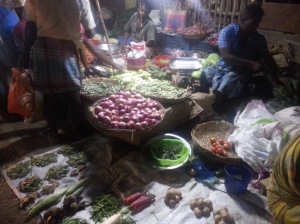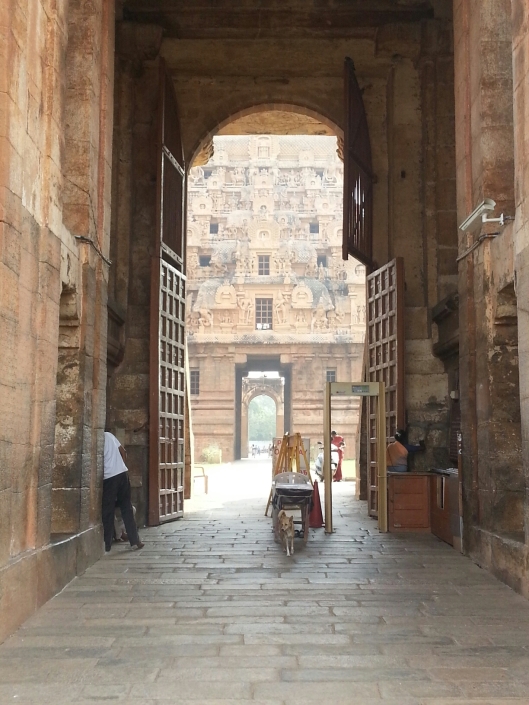Tags
Brihadishwara, India, Indian Railways, rail, railways, Schwarze, Schwarze's Church, Sivaganga, South India, Tamil Nadu, Tanjore, temples, Thanjavur
An hour by passenger train from Puducherry to Villaparam Junction, 10rps (10p) each, where we picked up the Trichy Express for the four hour trip south to Thanjavur, ‘rice basket of Tamil Nadu’, former capital of the great Chola Empire, location of the World Heritage designated Brihadishwara Temple and, naturally, another hot, dusty, crowded and noisy Indian city. We followed the injunction of the guide book and visited the famous temple twice. In the cool of the morning we entered through the massive Nayak gateway and the two gopuram to the vast open area within surrounded by colonnaded cloisters with their lingam shrines.
In front is India’s largest sculpture of Nandi, Shiva’s sacred bull, and beyond it the temple itself with its majestic 61 metre high vimana, a tower adorned with a dazzling display of carvings and sculptures. It was this that fixed our attention when we returned in the evening to watch the setting sun turn its stones from umber to pink to a glowing red and, high above us, the kites circling around its decorated top.

The restoration of Thanjavur’s Royal Palace, built by the Nayaks in the fifteenth century and later extended by the Maratha dynasty, is a work in progress. There was a gang of lunghi clad labourers toiling away in the midday heat carrying baskets and basins full of building sand on their heads and much of the site is overgrown. A 50 rupees ticket gave access to the Mahratta Durbar Hall where the Maratha rulers gave audience in the pavilion with its murals and brightly coloured columns, the Art Gallery with its bronze sculpture and, most interesting, the library that displays some of Serfoji II’s remarkable collection. This Nineteenth Century ruler had a real passion for collecting – some 65000 books and 50000 palm leaf and paper manuscripts and looking at some of the more fascinating ones on display occupied us for some time.
The sign beside the half open gate proudly announces that the Sivaganga Waterpark and Gardens is a Thanjavur City Corporation enterprise, and the entrance price – 30 rupees. It’s also the location of the Sivaganga Tank, built in the 16th Century to provide water for the city, so definitely worth a look. Someone had high hopes for this place once. To mark the 1994 World Tamil Conference, motor boats offering pleasure rides on the tank were introduced and they still seem to be here, beached and abandoned on the overgrown bank of the tank.
Through the half open gate we are greeted by an eight foot fibre glass giraffe a dinosaur and a gorilla. A sorry looking red toy train sits rusting and detached from its carriages, its wheels silted up with sand, and looking as if it’s been a long time since it carried passengers on the track that runs around the water park. There is is still water in the pool at the bottom of the slides which sit drunkenly on their supports but the tiles are green with algae. Washing hangs from a line above the empty ticket office. The ‘Canteen’ is padlocked shut, the chairs and tables stacked in the dusty forecourt.

 Then there are the animal cages. One says ‘Pigeon’. It seems to be empty but it’s too dark to see inside. The next says ‘Rat’ and ‘Rabbit’. We can see half a dozen rabbits but no sign of a rat. In a cage that says ‘Parrot’ there are three white geese. But the park hasn’t been entirely abandoned. Bizarrely the water sprinklers are spraying an island of grass and two women are sweeping up fallen leaves. There must be a story to the park’s sad demise but we don’t know what it is.
Then there are the animal cages. One says ‘Pigeon’. It seems to be empty but it’s too dark to see inside. The next says ‘Rat’ and ‘Rabbit’. We can see half a dozen rabbits but no sign of a rat. In a cage that says ‘Parrot’ there are three white geese. But the park hasn’t been entirely abandoned. Bizarrely the water sprinklers are spraying an island of grass and two women are sweeping up fallen leaves. There must be a story to the park’s sad demise but we don’t know what it is.

Outside is the entrance to Schwarz’s Fort Church. Built by an 18th century Danish missionary, polyglot and sometime diplomat, it’s a place full of atmosphere; inside the plaques and tablets poignantly prompt questions about the lives these early missionaries and colonists led and the deaths they met so far from home: ‘….. aged 32, wife to the Chief Engineer ….’

Market Street comes alive at night, a raucous carnival of colour, light and noise. Hanging above the shops that stretch along it are flouncy girls’ dresses in garish lime green, tangerine, canary yellow, electric blue, candy pink. Music blares out from the stalls selling mobile phones. There are people crowded around the food and chai and coffee stalls, carts piled with grapes and pomegranates. A cow helps itself from a heap of shallots on a hand cart and a woman rushes to shoo it away. There are open fronted shops selling gleaming steel and copper pans, stacks of clay pots, huge sacks of rice, trays of spices and women sitting with a paltry selection of vegetables, beans and onions, spread out on a mat and dimly lit by oil lamps.



We leave in the morning for Tiruchchirippalli.
The photos on the blog were taken with a mobile phone. Check out Rob’s travel and landscape photography website for images taken with a camera of travels in India and beyond at
robdougallphotography.co.uk









Nice and informative post…..there r lot of uniqueness in this temple e.g. The huge cap of Tanjore big temple is constructed in such a way that the shadow of the Tanjore big temple Gopuram will not fall on the ground. It will just fall on itself….the top portion called Vimana is made up of a single stone weighing 80 tons…still its not clear that how did they manage to take this to the top!!!! amazing architecture. ..